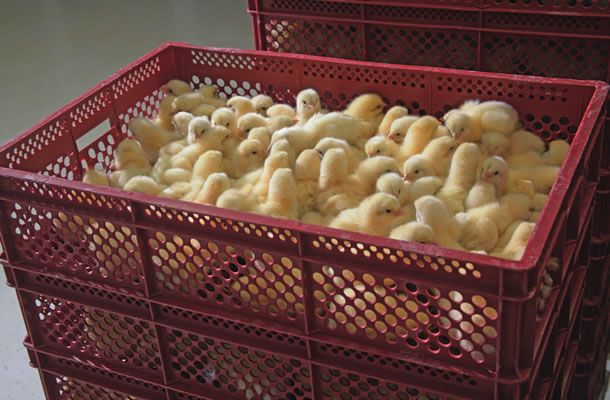Maintaining the ideal climate for chick handling and transport
Tags: Chick handling | Whitepaper
, 27 August 2010

Good post hatch performance and low first week mortality can best be expected from chicks kept in ideal conditions between leaving the hatcher and placement in the farm.
When pulled, chicks leave an ideal climate, with hatcher temperature of approx. 97.5 - 98 ˚F (36.4 - 36.7 ˚C), relative humidity at around 60 per cent and air circulating at high speed. Movement to the handling room exposes the chicks to a very different climate. And boxed chicks are often kept for some time in the chick despatch room, before being transported to the farm.
Normal rectal temperature for a day-old-chick is 40 - 40.5 ˚C (104.0 - 104.9 ˚F). Newly hatched chicks are dependent on climatic conditions to regulate their body temperature for the first few days. And good ventilation will drive excess body heat out of the chick boxes, while also preventing a build-up of carbon dioxide.
Chick behaviour is the best indicator of climatic conditions during chick handling and transport. Under ideal conditions, day old chicks breathe quietly through their nostrils, losing only a little water. They spread evenly in the boxes, make little noise and are relatively inactive.
If carbon dioxide levels are too high, the chicks will gasp for air and try to stick their heads out of the chick boxes. This blocks the passage of air into the boxes, so compounding the problem.
When environmental temperature is too low, or there is too much draught, the chicks huddle together to try to maintain body temperature. Chicks are especially prone to chilling if pulled too early (‘wet chicks’) or after spray vaccination.
Too high an environmental temperature causes chicks to open their beaks and pant, which evaporates water from their lungs and air sacs. Short term, panting will help the chicks to lose excess body heat, but it also leads to faster dehydration. When the chick’s water reserve is depleted, this control mechanism becomes redundant. With further increases in environmental temperature, the chicks become progressively more noisy, spreading their wings to try to reduce body temperature. But if environmental heat remains excessive, this too will fail to keep the chicks’ body temperature down - and inevitably some chicks will be lost.
Trying to prevent dehydration by increasing relative humidity only makes it more difficult for the chicks to evaporate water. Excessively low relative humidity also leads to dehydration.
Advice
Recommended post hatch climate settings are shown in the table below. Specific recommendations include:
- Look, listen and respond accordingly to the chicks’ behaviour. It may help to record the rectal temperatures of a representative sample of chicks occasionally.
- Remember that the room and/or truck climate is secondary: it is the climate in the chick boxes that matters. Temperature at chick level should be approximately 32 - 35 ˚C (89.6 - 95.0 ˚F).
- Avoid chilling by pulling chicks too early or after spray vaccination - and beware of draughts!
- Reduce the number of chicks when temperature during transport and (un)loading is too high.
- To provide sufficient ventilation in the chick-despatch room, position the chick boxes in uninterrupted rows with 30 cm (min) between each row, and a fan blowing preconditioned air in alternate corridors between the rows.
- Ensure that trucks are loaded correctly, based on the ventilation principle of the truck-type.
- Review the output of ‘climate loggers’ from the chick boxes during transit: the temperature in the boxes can be between 8 - 14 ˚C higher than the air temperature in the truck.
- Have the driver measure and record climatic conditions, including floor temperature, in the receiving farm.
- Unload the chick boxes immediately on arrival at the farm, as the house temperature is high and ventilation is too low to drive the additional heat produced by the chicks out of the boxes.
| Temperature (˚C) | Relative humidity (%) | CO2 (ppm) | Air flow | |
| Chick handling and dispatch | 22 - 28 | 50 - 60 | 500 - 600 | Sufficient |
| Truck | 22 - 28 | 50 - 60 | 500 - 600 | Sufficient |
| Farm | Air: 32 - 35 Floor: 28 - 30 |
50 - 60 | 500 - 600 | Negligible |
Written by Gerd de Lange
Senior Poultry Specialist
I welcome your feedback on this article - and if you require any additional information, please don't hesitate to contact me.